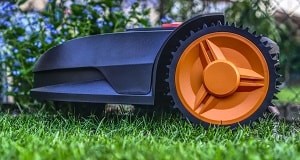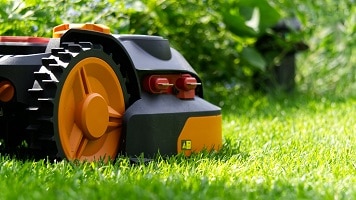- Making the Most of Your Smart Home: Common Use Cases - March 28, 2023
- Eco Mode at Night: Maximizing Nest’s Energy Savings - March 20, 2023
- Connecting & Controlling Smart Home Devices: A Guide - March 18, 2023
Disclosure: Links marked with * are Affiliate Links. As an Amazon Associate, I earn from qualifying purchases if you decide to make a purchase through these links – at no cost for you!
Almost all good robot lawn mowers navigate with a perimeter wire. The installation of the perimeter wire, however, is very laborious and takes hours!
Are there mowing robots without perimeter wires by now? Yes!
Okay, there is only one at the moment, but if your garden is not too big, you should get along with it very well.
The best robot lawn mower without perimeter wire is the Ambrogio L60.
This article contains a review of the Ambrogio L60 and further information about navigation systems of mowing robots.
If you don’t like the Ambrogio L60, take a look here: 🏆 The Best Robot Lawn Mowers – [List + Buying Guide]
Table of Contents
Ambrogio L60 Review
The Ambrogio L60 is currently the only mowing robot that can do without a perimeter wire. You can compare it very well with robot vacuum cleaners because its navigation is very similar.
Features:
The most important features of the Ambrogio L60 are listed here:
- Navigation: As soon as he detects the edge of the lawn with his “Smart Grass” sensors, he turns in a random direction and continues mowing until his battery is empty. The sensors also detect obstacles and holes. You just place the mowing robot on your lawn and let it go. When he’s done, all you have to do is collect him and hang him on his charger – done.
- Low weight: Since you have to lift the lawnmower robot more often to put it on the lawn and pick it up again at the end, it has also been designed and constructed to weigh very little.
- Battery life: With its rechargeable 2.5 Ah, 26-volt lithium-ion batteries, it can mow the lawn for up to 2 hours and takes only 3 hours to fully recharge. The charging station is of course included in the delivery.
- All-wheel drive: The Ambrogio L60 can drive effortlessly on lawns with gradients of up to 50% thanks to its all-wheel drive.
- Eco Mode Sensors: It also has special sensors that detect and avoid already cut grass. This makes it even more efficient and avoids already cut surfaces.
- Easy to use: With the included app you can not only install software updates directly on the lawnmower but also operate it. However, it can not only be operated via the app but also via the buttons on top of its housing. In addition to a start, pause and a large red stop button, there are also displays for the battery status.
- Low noise: With a maximum of 65 decibels, the robotic lawn mower is not very loud. But it is still considerably louder than our number 1 among mowing robots, the Husqvarna 430X*, with only 57 decibels.
- Security features: In addition to the large red emergency stop button on the top of the housing, the mowing robot also has built-in sensors that enable it to detect when it is tipped over. As soon as he notices this, he switches off the rotating knife immediately. Especially in households with children or pets, this is very important because you can’t keep an eye on the 100% of the time and something can always happen. To be absolutely sure, I would still only let the mowing robot mow when the children or pets are not free in the garden for two hours.
Technical Data
Here are the technical data at a glance:
- Lawn area: 200 m²
- Charging station included
- Battery life: 2 h
- Charging time: 2 h
- Cutting width: 250 mm
- Cutting height: 42 mm to 48 mm
- Rechargeable batteries: 2 x 2.5 Ah, 26 V lithium-ion batteries
- Blade rotation: 4000 RPM
- Weight: 8,3 kg
- Noise level: 65 dB
- Slopes: 50%.
- Ambient temperatures: -10 to 40 °C
- Emergency stop in case of overheating
- Emergency stop button on the upper side
- Various grass sensors
- Size: 440 x 200 x 360 mm
Pros & Cons: Ambrogio L60
Pros:
- No perimeter wire!
Minimal installation effort - 4-wheel drive
- Manages slopes of up to 50%
- 2 hours of non-stop operation
Cons:
- Does not drive automatically to the charging station
- Only 200 m²
- Detects no water or flower beds, only grass and hard surfaces
- Manual start, no schedules
Why is there only one Robot Lawn Mower without a Perimeter Wire?
The problem is navigation. Navigation with a boundary wire is currently the simplest and most favorable form of orientation for a mowing robot.
Somehow the mowing robot doesn’t just need to know where the lawn ends, it also needs to know exactly when to turn in order not to destroy your beautiful flower beds.
There are several approaches being worked on, but none of them is yet effective as far as the perimeter wire method is concerned. As an example, GPS navigation is not yet so precise that the mowing robot knows exactly where it is to the centimeter. If that were the case, the problem would be solved immediately.
However, I am very sure that in the medium term there will be mowing robots that can do without a perimeter wire. There will be some other sensors or cameras, similar to self-driving cars, that can show the robot where it is. It will probably work today, too, but the mowing robot would be ten times as expensive.

This means that at the moment we have to be satisfied with mowing robots that either navigate like the Ambrogio L60 with touch sensors or with perimeter wires.
If you don’t have the ideal garden for the Ambrogio L60, you should seriously consider choosing a mowing robot from my list of the best mowing robots.
These modern robot lawnmowers, which can also keep up with the Ambrogio L60 price-wise, have other very valuable advantages besides the disadvantage that you have to lay a perimeter wire, such as automatic mowing according to schedules and automatic recharging.
In addition, there is now even an Amazon installation service for lawn mowing robots. So you can get one of the best robot lawn mowers and still avoid the tedious installation and hours of digging up your lawn and crawling on the ground.
Current Navigation Methods of Robot Lawn Mowers
Even though the use of perimeter wires is currently the simplest and most cost-effective way to give a mowing robot a sense of direction, most mowing robot companies are still looking for better systems or combinations of them.
In the following, all currently used navigation methods of mowing robots are presented.
Navigation by Perimeter and Guide Wire
With this navigation method, wires are laid at the edge of the lawn at a certain distance from the edge of the lawn. However, they are not just laid on the grass but also buried at a certain depth in the ground.
This wire can be detected by built-in sensors in the mowing robot. If the robot lawn mower drives over this wire, it notices this and can react accordingly. The usual reaction to this is, of course, to stop, turn around and continue mowing in another direction.
In most cases, the perimeter wire is connected to the charging station, which serves as the base for the mowing robot. The charging station can check the closed circuit of the wire and thus knows whether a hole has formed somewhere over time (e.g. due to rust or pests).

There are also mowing robot systems that work with a guidewire in the middle of the lawn in addition to the perimeter wire. The guidewire is used to guide the robotic lawn mower back to its charging station as soon as it has a low battery level.
Through the random principle of his navigation, it will constantly drive over this guidewire, which also allows it to quickly find its way back to its charging station when it needs to recharge.
The big disadvantage of navigation with perimeter and guidewires is, of course, the effort of the first installation. Depending on the size of your garden, this may take several hours of work.
Pros & Cons: Perimeter and Guidewire
Pros:
- Exact lawn boundary
- Robotic lawn mower does not destroy beds
- Mowing robot cannot fall into a hole, pond or pool
- A guidewire for a quick return to charging station
- Different mowing robot systems can use the same perimeter wire (no replacement required for a new mowing robot)
Cons:
- Tedious installation
Navigation via GPS
GPS has the potential to eliminate the entire navigation problems of mowing robots. At the moment, however, it is only accurate to a few meters for the normal user. And of course, this is absolutely not enough to define the edge between the lawn and the bed.
Nevertheless, many robotic lawn mowers nowadays have GPS support. Especially high-end devices often offer this feature. However, it is not used to determine the lawn boundary, but for path optimization and as a safety feature.

The safety aspect is not to be neglected with lawn mowing robots, since they are mostly not cheap and in addition still alone in your garden. Depending on what neighborhood you live in, this could be an attractive prey for thieves.
In addition to the normal anti-theft systems such as an authentication process, GPS, of course, offers the possibility to locate the stolen mowing robot.
Good lawn mowing robots with GPS also integrate their GPS signal into their software in order to record the mown area and offer the user optimization possibilities.
In any case, we can expect in the future that the accuracy of GPS will also continue to increase in the non-military sector. However, it only becomes particularly relevant for mowing robots when this accuracy has been reduced to centimeters, because only then can your robot lawn mower draw the exact line between your rose bed and your lawn.
Pros & Cons: GPS Navigation
Pros:
- Theft localization
- Efficiency optimization through GPS possible
Cons:
- Not yet precise enough for the boundary of the lawn area
Navigation via Camera
Self-driving cars are all over the press right now. Why shouldn’t this autonomous navigation via camera spill over into other areas?
Of course, it will take some time before this technology is more widespread and can also be cost-effectively integrated into products such as mowing robots, but the potential is huge.
With a powerful software or even an AI and the necessary cameras, a mowing robot could not only recognize the lawn independently but also the height, health and other characteristics of the lawn. It could, for example, let you know if something is wrong with the lawn or give you tips on how to care for it. The possibilities are actually unlimited since a smart optical system resembles the sensors of a human being – the eyes.
I think that this technology will eventually make a big impact on robotic lawn mowers and lead to great optimizations. It is only a matter of time until the first models are on the market!
Pros & Cons: Navigation via Camera
Pros:
- Perfect navigation
- Infinite possibilities for optimization
Cons:
- Dreams of the future – there are still no lawn mowing robots with such a system 🙁
Navigation via Other Sensors
The Ambrogio L60 is the only mowing robot that navigates in a completely different way. In addition to its touch sensors for large obstacles, it also uses moisture sensors that detect the difference between the grass and hard surfaces such as stones.
As soon as the robot lawn mower reaches the edge of the lawn and drives onto the terrace, it notices this and turns around. However, there is a big disadvantage to this navigation method. These humidity sensors cannot distinguish between two completely different surfaces that have the same humidity. For example, they cannot distinguish between a lawn and a bed. Also, the robot would not recognize a pond or pool and drive into them.
Who knows what the development department of the company is doing right now, but it could be that besides humidity sensors also simple cameras can distinguish green from brown or even grass from plants in the bed are already in development. Then this problem would be solved.
Pros & Cons: Other Sensors
Pros:
- No tedious installation of wires necessary
- Has the potential to improve navigation even further with additional sensors
Cons:
- Can’t distinguish between lawn and bed
- Limited to lawns with hard surfaces or obstacles as boundaries
Bottom Line
You were looking for a robot lawn mower without a perimeter wire and in this article, you got to know the Ambrogio L60 with all its advantages and disadvantages.
If your garden is suitable for this mowing robot, it is a very good choice, as you save yourself the tedious first step of installation.
If, however, your lawn is bordered by beds, you would first have to border the lawn differently or switch to a different mowing robot. There are many attractive robot lawn mower models available with a number of smart features that the Ambrogio L60 does not have.
If you would like to compare the Ambrogio L60 with other models, you can either take a look at our number 1, the Husqvarna 430X*, or check out the best mowing robots on the market today in this article.
Attention: When installing electronic equipment, please be sure to observe the manufacturer’s safety instructions. You have to take care of your own safety. The information on this site only helps you to learn.
Disclosure: This website is the property of Martin Lütkemeyer and is operated by Martin Lütkemeyer. Martin Lütkemeyer is a member of the Amazon Services LLC Affiliate Program, an affiliate advertising program designed to enable Web sites to earn advertising revenue through advertising and linking to Amazon.com. Links marked with * are affiliate links.
